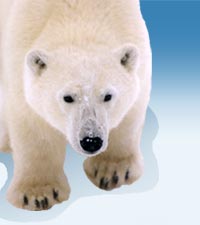
Time to Eat
| What's for Dinner? Fatty foods may not be healthy for people, but they are the best foods for polar bears. Polar bears like to eat ringed seals and bearded seals, occasionally beluga whales and sometimes even walrus because all of these animals have lots of fat on them. During lean times, such as the summer, polar bears will eat just about anything, including bird eggs, rodents, berries, seaweed, grass and even rotting animals. Polar bears have been known to come near towns to eat from their garbage dumps. Polar bears don't catch fish in the wild. Only polar bears in zoos eat fish. |
| Hunting A polar bear's white coat is excellent camouflage in the snow. In a world of white, a little black nose can be seen from far away. Some people claim that polar bears have been seen putting their paw over their black nose to hide it. "Still Hunting" - Most polar bears catch their food by "Still Hunting". This means that they smell out a seal's breathing hole and wait for a seal to swim to the surface for a breath of air. When the seal comes along, the bear bites it and uses it's huge paws to flip the seal up on to the ice. Most of the time a bear only has to wait for an hour, but they will wait much longer if they have to. Stalking - Stalking is a way that polar bears will catch food on warm days when seals are lying on the ice in the sun. A polar bear will try and sneak up on a seal, either from on the ice or swimming up from the water. When the bear is close enough, it will charge at the seal and hope to catch it before it escapes into the water. It is similar to the way that cats will try and sneak up on birds to catch them. Seals - Seals have their babies in snow caves on the ice. If a bear is lucky and can find one of these snow caves he or she will sneak up on it. The bear will then jump on the roof of the cave to break though and catch the seals. This is a common way for a mother bear and cub to hunt. Beluga Whales - Occasionally ice traps beluga whales far from the open ocean and polar bears will try and catch them when they come up for air. Young belugas are also at risk if they swim too close to a polar bear. Walrus - A large adult walrus will usually be too much trouble for a polar bear to handle, but a young or injured walrus may be an easy meal. A polar bear may sneak up on a walrus relaxing in the sun, and jump on it. |
| Eating Once a seal is caught, the polar bear carries the seal away from the water to make sure the seal doesn't escape. The skin and blubber are eaten first and if the meat is eaten at all, it is eaten last. Polar bears have big stomachs. A 500kg (1100lb) bear can fill its stomach with 75kg (165lbs) of food. (Yikes, that's how big I am!) Their big stomachs let them eat large meals every few days instead of having to hunt all the time. The blubber is swallowed in large chunks because the bears don't chew their food very much. To stay white and camouflaged, the bears will stop eating and spend a few minutes cleaning themselves by rolling in the snow or water before returning to eat again. |
| Drinking When polar bears are on the sea ice, there is little or no fresh water for them to drink. All the ice they are on is made of salt water, which is not good to drink. When a polar bear eats fat and blubber, they digest it into energy and water. They get all the fresh water they need from the fat they eat. Pretty cool, eh? Arctic foxes and birds usually eat any leftover meat. When the ice melts, the bones fall into the ocean. |
| Why eat so much blubber? Many animals will eat all summer to survive the winter, but polar bears do the opposite; polar bears eat all winter to survive the summer. A polar bear uses about 2kg (4.5lbs) of fat each day just to survive. In the summer, when polar bears can't hunt seals (there is no ice to stand on!) they can go for several months without a big meal. If the summer lasts 90 days (3 months) and a polar bear doesn't catch a seal during that time, but loses 2kg each day, that's 180kg (400lbs). Polar bears can have big weight changes and still stay healthy as long as they eat lots during the winter. |
All photos and images are for use at the author's discretion.
Please gain permission before using.
Copyright © 2000-2004 mikepolarbear@yahoo.ca
Please gain permission before using.
Copyright © 2000-2004 mikepolarbear@yahoo.ca

